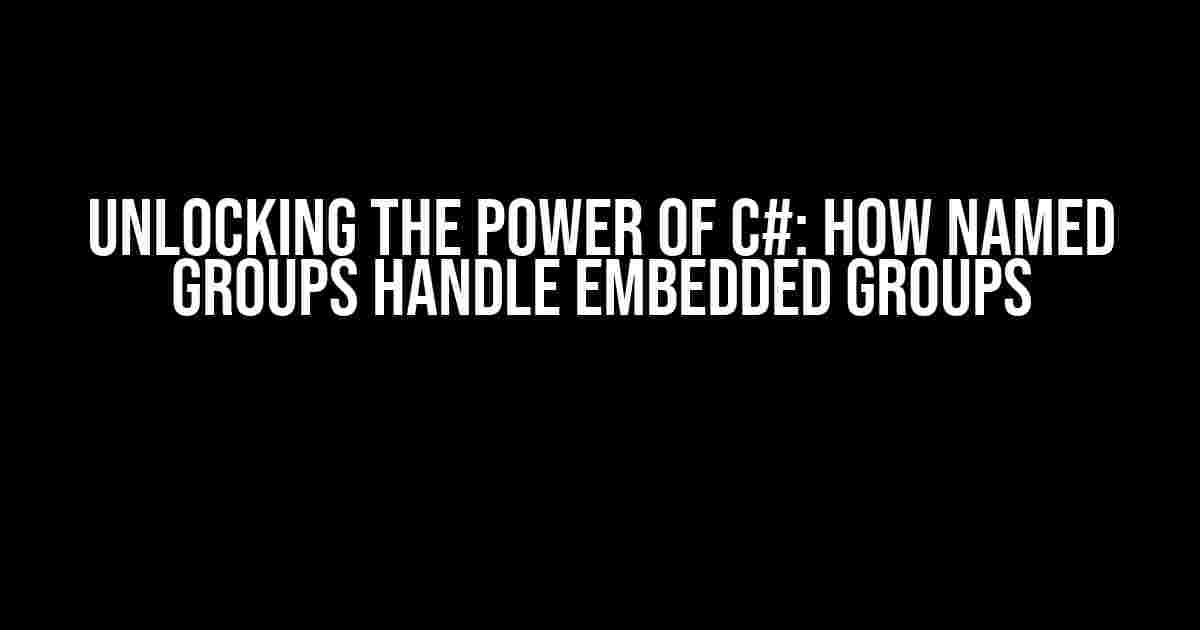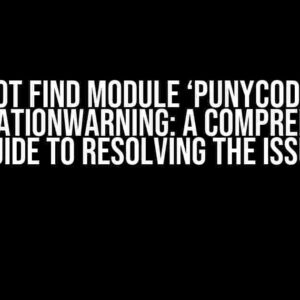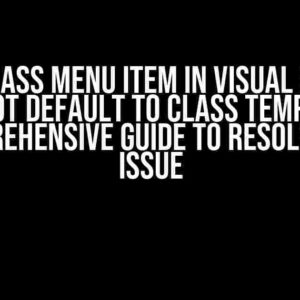C# is a powerful programming language that offers a wide range of features to make coding easier and more efficient. One of these features is the ability to use named groups in regular expressions, which allows you to capture specific parts of a match and reference them later in your code. But what happens when you need to work with embedded groups? In this article, we’ll dive into the world of named groups and explore how they handle embedded groups, providing you with a comprehensive guide on how to master this powerful feature.
What are Named Groups?
In C#, a named group is a regular expression group that is given a name using the syntax `(?’name’pattern)`. This allows you to reference the group later in your code using its name, rather than its numerical index. Named groups make your code more readable and easier to maintain, as you can clearly see what each group represents.
string pattern = @"(?'areaCode'\d{3})(?'exchangeCode'\d{3})(?'lineNumber'\d{4})";
string input = "1234567890";
Match match = Regex.Match(input, pattern);
Console.WriteLine("Area Code: " + match.Groups["areaCode"].Value);
Console.WriteLine("Exchange Code: " + match.Groups["exchangeCode"].Value);
Console.WriteLine("Line Number: " + match.Groups["lineNumber"].Value);
Embedded Groups: The Basics
An embedded group is a group that is contained within another group. In regular expressions, embedded groups are defined using parentheses `()`. When working with named groups, embedded groups can be a bit tricky to understand, but don’t worry, we’ve got you covered.
string pattern = @"(?' outerGroup' (?'innerGroup' \w+))";
string input = "hello world";
Match match = Regex.Match(input, pattern);
Console.WriteLine("Outer Group: " + match.Groups["outerGroup"].Value);
Console.WriteLine("Inner Group: " + match.Groups["innerGroup"].Value);
How Named Groups Handle Embedded Groups
When a named group contains an embedded group, the named group captures the entire match, including the embedded group. This means that the named group will contain the value of the embedded group, as well as any other characters that are part of the match.
string pattern = @"(?'groupName' (?'embeddedGroup' \w+) \w+)";
string input = "hello world";
Match match = Regex.Match(input, pattern);
Console.WriteLine("Group Name: " + match.Groups["groupName"].Value);
Console.WriteLine("Embedded Group: " + match.Groups["embeddedGroup"].Value);
In the example above, the named group `groupName` captures the entire match `hello world`, while the embedded group `embeddedGroup` captures the first word `hello`. The named group `groupName` contains the value of the embedded group `embeddedGroup`, as well as the remaining characters of the match ` world`.
Tips and Tricks
Here are some tips and tricks to keep in mind when working with named groups and embedded groups:
- Use descriptive names**: When naming your groups, use descriptive names that clearly indicate what each group represents. This will make your code more readable and easier to maintain.
- Use parentheses wisely**: When defining embedded groups, use parentheses to clearly define the scope of each group.
- Reference groups correctly**: When referencing a named group, make sure to use the correct syntax `match.Groups[“groupName”].Value`.
- Use the `Groups` collection**: The `Groups` collection provides a convenient way to access all the groups in a match, including embedded groups.
Common Scenarios
Here are some common scenarios where named groups and embedded groups are particularly useful:
| Scenario | Description |
|---|---|
| Parsing XML/HTML | Named groups can be used to capture specific tags and attributes, while embedded groups can be used to capture nested elements. |
| Validating Input | Named groups can be used to capture specific input patterns, while embedded groups can be used to capture optional or repeated patterns. |
| Data Extraction | Named groups can be used to capture specific data fields, while embedded groups can be used to capture nested data structures. |
Best Practices
Here are some best practices to keep in mind when working with named groups and embedded groups:
- Keep it simple**: Avoid using complex regular expressions that are hard to read and maintain. Instead, break down your regular expressions into smaller, more manageable pieces.
- Use named groups consistently**: Use named groups consistently throughout your code to make it more readable and easier to maintain.
- Test thoroughly**: Test your regular expressions thoroughly to ensure they work as expected, especially when working with embedded groups.
- Document your code**: Document your code clearly, including explanations of your regular expressions and how they work.
Conclusion
In conclusion, named groups and embedded groups are powerful features in C# that can help you write more efficient and readable code. By following the tips and tricks outlined in this article, you’ll be well on your way to mastering named groups and embedded groups. Remember to keep it simple, use named groups consistently, test thoroughly, and document your code clearly. With practice and patience, you’ll become a regular expression master in no time!
Further Reading
If you’re interested in learning more about regular expressions in C#, here are some additional resources:
Frequently Asked Question
Get ready to dive into the world of C#! In this FAQ section, we’ll explore how C#’s named groups handle embedded groups.
What are named groups in C#?
Named groups in C# are a way to assign a name to a capture group in a regular expression. This allows you to refer to the group by name instead of by index, making your code more readable and maintainable.
How do I define a named group in C#?
To define a named group in C#, you use the syntax `(?’name’pattern)`, where `name` is the name you want to assign to the group and `pattern` is the regular expression pattern you want to match. For example, `(?’foo'[a-zA-Z]+)` would match one or more letters and assign the match to a group named “foo”.
How do I access a named group in C#?
To access a named group in C#, you can use the `Match` object’s `Groups` property, which returns a `GroupCollection` object. You can then access the named group by its name using the `Groups` property’s indexer, like this: `match.Groups[“foo”].Value`.
Can I have multiple named groups with the same name?
No, you cannot have multiple named groups with the same name in C#. The .NET regular expression engine does not allow duplicate group names, and will throw an `ArgumentException` if you try to define multiple groups with the same name.
How do I handle embedded groups in C#?
To handle embedded groups in C#, you can use the ` Groups` property’s indexer to access the parent group, and then access the child groups recursively. For example, if you have a regular expression like `(?’outer'(?’inner'[a-zA-Z]+))`, you can access the “inner” group like this: `match.Groups[“outer”].Groups[“inner”].Value`.






